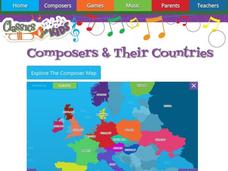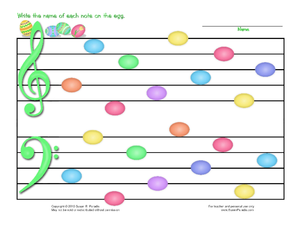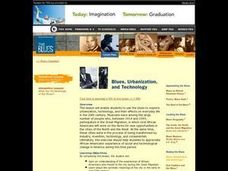Civil War Trust
The Common Civil War Soldier
Imagine you are a soldier in the Civil War. What are you wearing? What do you need to carry with you? Examine the life of a person during the Civil War, from drummer boys to powder monkeys to musket-toting soldiers. Elementary learners...
Classics for Kids
Composers and Their Countries
How many of the world's greatest composers were born in Austria? Or Germany? Or the United States? An interactive map provides young musicians with information about prominent composers in the last few centuries, as well as the periods...
Historic New Orleans Collection
Exploring Primary Sources: Music in New Orleans
Looking for a new and exciting way to teach young historians the art of primary source analysis? Jazz up your lesson with a resource that asks class members to analyze photos, travel documents, and letters written by some of New Orleans'...
College Board
2017 AP® Psychology Free-Response Questions
How does psychology affect other parts of people's lives? Scholars consider scenarios such as how stress affects a musician's audition or to what extent is a person's eating behavior connected to neurology. Analyzing such questions from...
North Carolina Consortium for Middle East Studies
Using Drama to Address Social Justice Issues in School and the Community
Artists, musicians, and dramatists have long been the leaders in the quest for social justice. To gain an understanding of the power of the arts to address social issues, class members listen to a reading of Drew Daywalt's The Day the...
Smithsonian Institution
Spirits Across the Ocean: Yoruban and Dahomean Cultures in the Caribbean Brought by the Slave Trade
Much of Latin American music owes its origins to the slave trade. Peoples from the Yoruban and Dahomean cultures brought with them the distinctive rhythms, time signatures, and eighth note patterns that now characterize Caribbean music....
Smithsonian Institution
Braiding Rhythms: The Role of Bell Patterns in West African and Afro-Caribbean Music
Africans transported to the Caribbean as part of the transatlantic slave trade brought with them a rich tradition of music and dance. Four lessons teach young musicians the rumba clave rhythm, cascara rhythm, and the 6/8 bell patterns...
Smithsonian Institution
The Vocal Blues: Created in the Deep South of the U.S.
Bring the sounds of the deep South vocal blues to the classroom with a Smithsonian Folkways lesson. In preparation, scholars listen to and count the 12 bar blues patterns in several works and identify the I, II, IV, and V chords as well...
Smithsonian Institution
Jamaican Song, Dance, and Play: Experiences with Jamaican Musical Traditions
Young musicians experience song, dance, and play of the Jamaican culture. Scholars listen for and recreate beats, they play tunes, make up original dances, and play a game that challenges pupils to pass stones to a specific beat.
John F. Kennedy Center
Musical Harlem: How Is Jazz Music Reflective of the Harlem Renaissance?
Bring jazz music and the Harlem Renaissance to light with a lesson that challenges scholars to research and create. Pupils delve deep into information materials to identify jazz terminology, compare types of jazz and jazz musicians,...
K20 LEARN
Jazz In Oklahoma
When considering the possible hot spots of jazz in the United States, Oklahoma isn't the state that first comes to mind. However, it is the birthplace of several jazz musicians that influenced the evolution of the genre and Oklahoma City...
Curated OER
Diversity Day
Eleventh graders explore a variety of different cultures and their traditions. They complete an evaluation and short reflection of the day on the following prompts: I learned I... and I wish I... Each student then observes and talks with...
Curated OER
Bessie Smith
In this jazz history worksheet, students respond to 7 essay and short answer questions about the life and accomplishments of Bessie Smith.
Curated OER
Tennessee: The Volunteer State Part 2
If you're planning a trip to Tennessee or just teaching a lesson on the state, you'll find this resource very useful. The agriculture, industry, music, and demographics of the state of Tennessee are discussed. This is the second in a...
Curated OER
General Music: Star Spangled Banner
"The Star Spangled Banner" became our country's national anthem, but why? Second and third grade musicians read about the song, analyze the lyrics, and discuss patriotism. They then complete a related word search.
Curated OER
Easter Egg Musical Notes
Pastel Easter Eggs are all over this staff, and it's up to your young musicians to analyze each one. They write the name of the note in each egg to practice identifying notes while reading music.
San Francisco Symphony
The American Five - Pentatonic scales in early American melodies
Through vocal warm-ups and exercises, budding musicians will attempt to grasp the five pentatonic scales, commonly used in early American songs. They'll sing and work to identify the pitch, tone, melody, and scales being expressed in the...
Curated OER
The Modern Day Minstrel - Lesson 1
Students identify and describe the various roles that musicians fulfill. They recognize various genres of music. They identify and interview musicians in the community and invite them to come in and talk about their roles as musicians.
Curated OER
Cut and Paste Biographies
Young scholars explore the influence of African-American artists, writers, and musicians on American culture. After researching different figures in these areas, they create collages representing each person's life and legacy.
Curated OER
The Harlem Renaissance
The Harlem Renaissance inspired a group of writers, musicians, and artists whose influence is still seen today.
Curated OER
Social Studies, Music, The Blues, Urbanization, and Technology
Enable students to use the blues to explore urbanization, technology, and their effects on everyday life in the 20th century. Musicians were among the large number of people who, between 1914 and 1945, participated in the Great Migration...
Midwest Clinic
Latin Rhythms: Mystery Unraveled
There is an indescrible energy to Latin American music—but if you know your music theory, it's not so indescrible after all. A thorough packet provides definitions for terms like bolero, charanga, shekere, and tumbao before listing...
Smithsonian Institution
American Sabor: Word Search #1
Find la guitarra and el charango with a short and straightforward word search focused on Latin American music. Learners check through a list of popular instruments and dances before delving into the puzzle.
Smithsonian Institution
Latino Expression
How much of your daily life is influenced by Latin American music? Take a listen—the answer may surprise you! High schoolers keep a journal to note any instances they see Latino culture represented, including the media, their school, and...
Other popular searches
- Bremen Town Musicians
- Famous Black Musicians
- Jazz Musicians
- Black Musicians
- Blues and Jazz Musicians
- Biographies of Musicians
- Musicians of Bremen
- Musicians Roles in Society
- African American Musicians
- Composers Musicians
- 1940 Black Musicians
- New Orleans Musicians

























